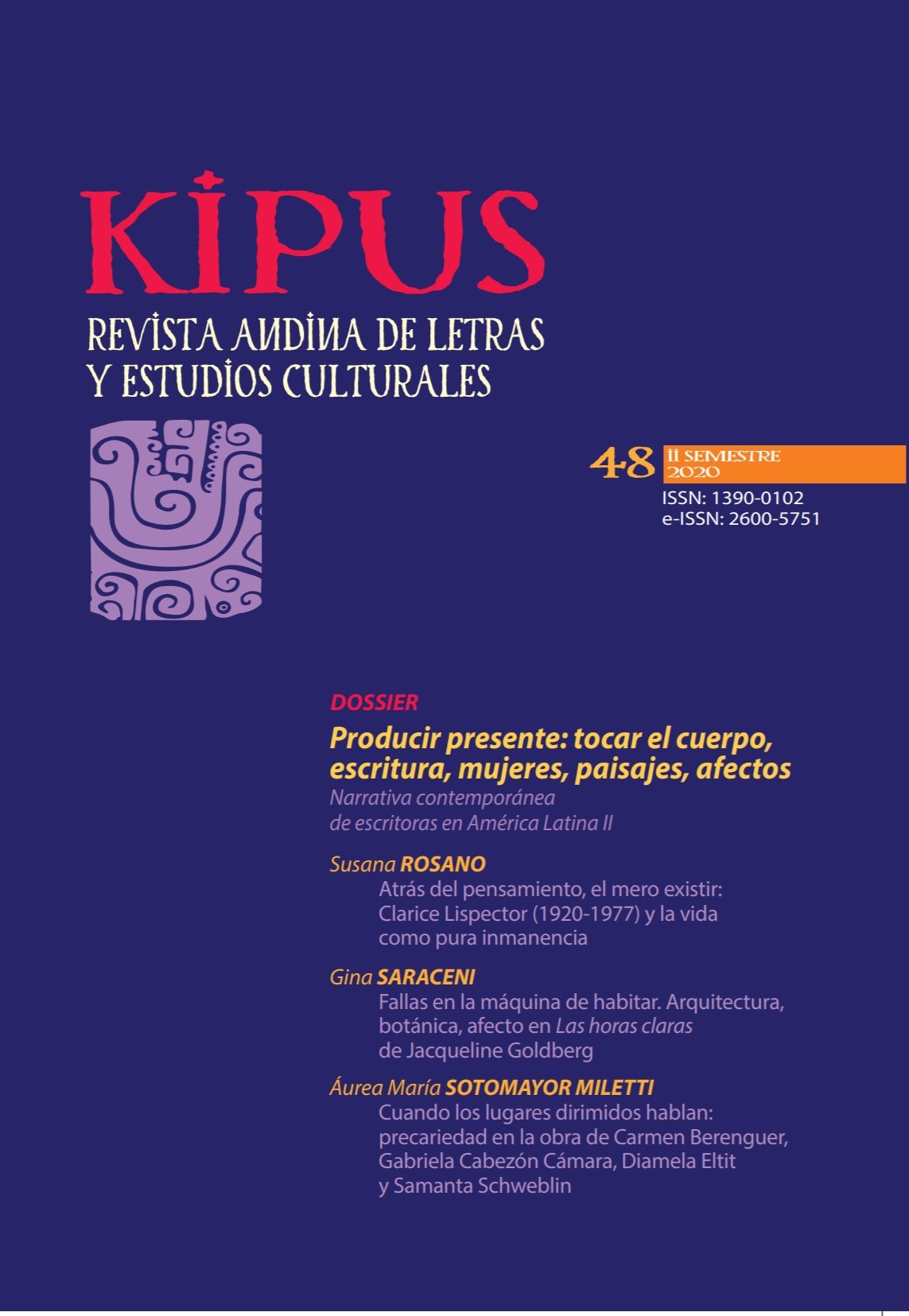Giovanna Rivero: Thinking with the Terrible Young Girl and Fragmentation in new South American Narrative
DOI:
https://doi.org/10.32719/13900102.2020.48.6Keywords:
terrible young girl, desiring theories, fragmentation, young girl, Latin America, writing, womenAbstract
The author begins by challenging the conventional perception of “the young girl” as a social and historical subject, from a perspective that invites us to “listen to her talk” and to “think with her”. From here, and from the practice of a “desiring theory” (that does not capture identities but casts becomings), the article analyzes various emblematic narratives to appreciate the “anti-oedipal tessitura” of the young girls who appear as their protagonists: the protagonist of Jorge Luis Borges’ famous short story, “Emma Zunz”, certain fables and prose poems by Marosa di Giorgio, the novel “Papi” (2005), by Rita Indiana, author of what she calls the “Trilogy of Unbearable Girls”. Special attention is brought to, 98 segundos sin sombra (2016), a novel by the Bolivian author Giovanna Rivero, which presents not so much the writer as a young girl, but the young girl as a writer, as well as some of her writings from the book of short stories Para comerte mejor (2016). The desiring theory produced by Giovanna Rivero and her characters does not lead to certainties but to growing uncertainties. Her stories are among the most suggestive and mysterious when it comes to women protagonists in Latin American literature.
Downloads
References
Amícola, José. 2014. “Las nenas terribles de Silvina Ocampo y Marosa di Giorgio”. Cuadernos LIRICO 11. http://lirico.revues.org/1847.
Deleuze, Gilles, y Félix Guattari. 2004. Mil mesetas. Capitalismo y esquizofrenia. Traducido por José Vázquez Pérez. Valencia: Pretextos.
Di Giorgio, Marosa. 2013. El Gran Ratón Dorado, el Gran Ratón de lilas. Relatos eróticos completos. Buenos Aires: El Cuenco de Plata.
Duchesne Winter, Juan. 2009. Comunismo literario y teorías deseantes: inscripciones latinoamericanas. La Paz: Plural Editores.
Haraway, Donna. 2016. Staying with the Trouble. Making Kin in the Chthulucene. Durham: Duke University Press.
Indiana, Rita. 2005. Papi. San Juan: Vértigo Editores.
Kennedy, Jen. 2015. “The Young-Girl in Theory”. Women & Performance: A journal of feminist theory 25 (2): 175-94.
Manchev, Boyan. 2016. “Die Töchter der Gaia. Das Philosophisch-Fantastiche und Göttertransplants/The Daughters of Gaia. The Philosophical Fantastic
and Transplants of Gods”. En Elisabeth von Samsonow. Transplants, editado por Nikolaus Kratzer, Felicitas Thun-Hohenstein, Elisabeth von Samsonow y Heidrun-Ulrike Wenzel, 159-69. Bielefeld: Kerber Verlag.
Melitopoulus, Angela, y Maurizio Lazzarato. 2011. “Anti-Elektra. A conversation with Elizabeth von Samsonow”. En Animismus. Moderne hinter den Spiegein/Animism. Modernity Through the Looking Glass, 199-209. Vienna: Generali Foundation.
Rahman, Ebadur. 2016. “Knäuel. Urgeschiste einer endosymbintischen Plattform/ Clew. The Prehistory of an Endosimbiont Platform”. En Elisabeth von Samsonow. Transplants, editado por Nikolaus Kratzer, Felicitas Thun-Hohenstein, Elisabeth von Samsonow y Heidrun-Ulrike Wenzel, 103-17. Bielefeld: Kerber Verlag.
Rivero, Giovanna. 2016a. 98 segundos sin sombra. La Paz: El Cuervo.
–––. 2016b. Para comerte mejor. La Paz: El Cuervo.
Schantl, Alexandra. 2016. “Zu Elisabeth von Samsonows schizosomatischer Theorie und bildhauserischer Praxis Ein Versuch der Synthese/Elisabeth von Samsonow’s Schizomatic Theory and Sculptural Practice. An Attempt at Synthesis”. En Elisabeth von Samsonow. Transplants, editado por Nikolaus Kratzer, Felicitas Thun-Hohenstein, Elisabeth von Samsonow y Heidrun-Ulrike Wenzel, 39-51. Bielefeld: Kerber Verlag.
Tiqqun. “Primeros materiales para una teoría de la Jovencita”. Traductor desconocido. https://tiqqunim.blogspot.com/2013/11/primeros-materiales-para-una-teoria-de.html.
Von Samsonow, Elisabeth. 2007. Anti-Elektra. Totemismus und Schizogamie.Zürich/Berlin: diaphanes.
–––. (s. d.). “Chapter One. Electra as Female Oedipus”. Disponible en https://es.scribd.com/document/274484985/. Anti-Electra-English-Translationby-Stephen-Zepke-and-Anita-Fricek-Chapter-One.
Downloads
Published
How to Cite
Issue
Section
License

This work is licensed under a Creative Commons Attribution-NonCommercial-ShareAlike 4.0 International License.








.png)
